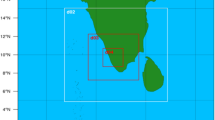Summary
The development of a thunderstorm which is essentially a convective phenomenon needs a cause for initial convection and then conditions for its maintenance once started. The possibility of the inherent instability due to potentially colder air superposed on potentially warmer air or the analogous case of extra injection of moisture in the lower layers in shown to be not applicable in nature and that causes for initial convection must be found elsewhere than in the potential density distribution. Some of the causes are non-horizontality of surfaces of equal temperature and equal humidity; and gradient of wind velocity. It is shown that upward rise of air produced by unequal heating of the ground, does not stop where the rising mass of air attains a density equal to that of the environment (hydrostatic equilibrium), but continues to rise higher till the momentum developed is reduced to zero. The extent of over-shooting is nearly of the same order as the height between the initial level and the level of hydrostatic equilibrium. Once the condensation level is reached, it is well known that the convection will become regenerative due to the evolution of the latent heat of condensation. In the usual treatment of the problem, the ascending parcel of air is expected to condense at or before it reaches the level of hydrostatic equilibrium if it is to develop into a thunderstorm. The dynamical treatment outlined in this paper takes into consideration the overshooting of the parcel of air and thereby allows much drier air to reach condensation and thereafter maintain convection: and can thus account for a larger number of thunderstorms.
Similar content being viewed by others
References
Rayleigh,Phil. Mag.,32, 529.Coll. Works,6, 432. Low,Nature,65, 299. Brunt,ibid. Nature,65, 300. Jeffreys,Phil. Mag., 1926,2, 833 andProc. Roy. Soc., 1928,118, 195. Low,Proc. Roy. Soc., 1929,125, 180. Jeffreys,Proc. Camb. Phil. Soc., 1931,26, 170. Malurkar,Gerland’s Beitr. Geophys., 1937,51, 270. Hales,Proc. Roy. Soc.,151, 624. Also Malurkar in the Abstracts Nos. 28, 29, 37 of 1937 of the Physics Section of the Indian Science Congress.
Taylor,Phil. Trans. Roy. Soc., 1915,215, 1.
Additional information
Substance of a colloquium given at the Meteorological Office, Poona, in March 1934.
Rights and permissions
About this article
Cite this article
Malurkar, S.L. Dynamics of thunderstorms. Proc. Indian Acad. Sci. (Math. Sci.) 18, 20–27 (1943). https://doi.org/10.1007/BF03046509
Received:
Issue Date:
DOI: https://doi.org/10.1007/BF03046509




